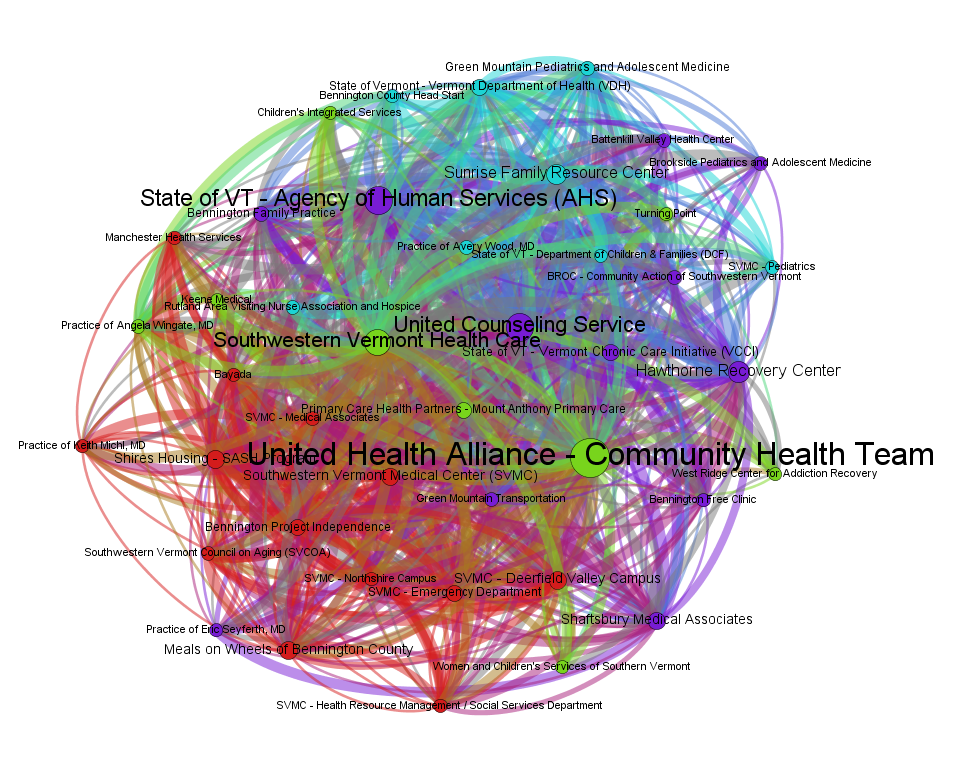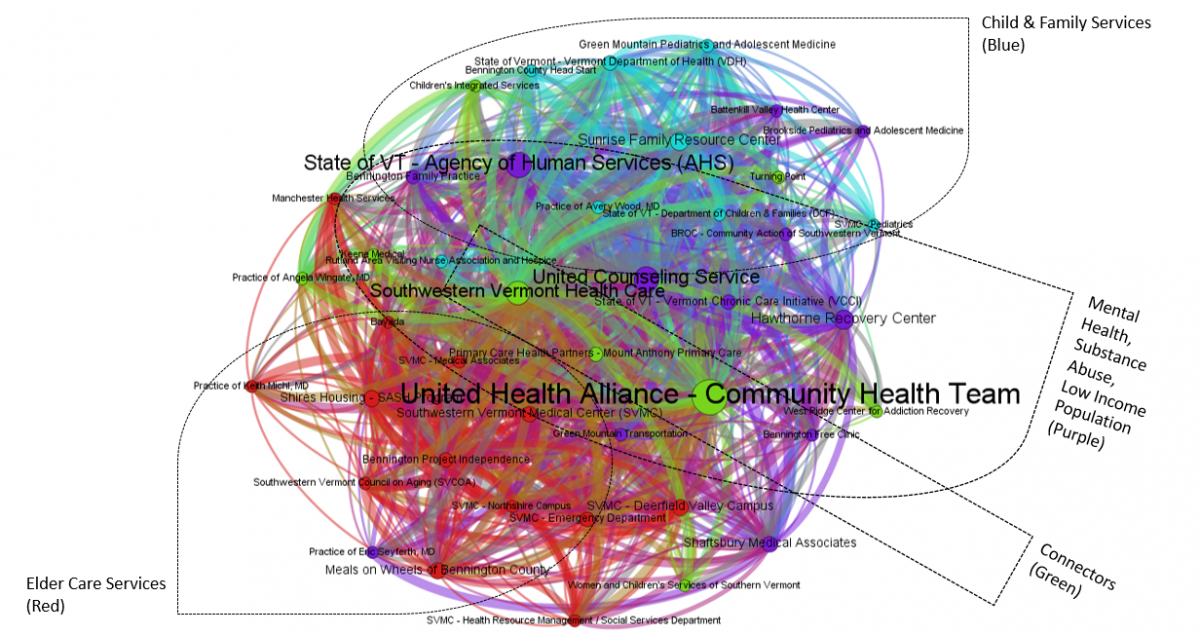The Blueprint's Community Network Analysis study describes the network of organizations that has emerged in each Blueprint HSA to support population health and individual health, focusing on modes of collaboration and relationships between organizations.
Vermont Community Health Networks Reports
| Vermont's Community Health Networks | 2015 |
| Assesment of Vermont's Health and Human Services Networks | 2014 |
Regional Network Reports
About the Vermont Community Network Analysis Study
The Challenge of Measuring Multi-Sector Community Networks
Vermont’s health care and human services organizations have partnered to varying degrees for as long as both have existed. The Blueprint strengthens these partnerships, by formalizing a convening role (the Project Manager) and workgroups (first the Integrated Health Services Workgroups, now the Community Collaboratives).
Anecdotal evidence abounds for the importance of this role and activity, but community network development had been difficult to quantify. In 2013, as part of the Blueprint program evaluation, contracted researchers trialed a new methodology for mapping and measuring community networks. This research was repeated, with improvements, in 2015.
Mapping and Measuring Blueprint Communities Using Network Analysis
Network Analysis offers an opportunity to visualize the community networks and quantify overall connectedness and the position of key organizations. The methodology begins with a survey of community partners in each HSA. Survey participants are asked to indicate how their organization interacts with each other organization listed in the survey, based on six types of interactions:
-
Having patients/clients in common
-
Sharing information about specific patients/clients
-
Sharing information about programs, services and/or policy
-
Sharing resources (e.g. joint funding, shared equipment, personnel, or facilities)
-
Sending referrals
-
Receiving referrals
The researchers then map relationships using network analysis software (Gephi). A force-based algorithm pulls connected organizations closer together and pushes unconnected organizations further apart, creating a picture representing each organization in a position that takes into account its relationship to every other organization in the network. This relationship is quantified in several ways, most importantly a centrality score.
Measures of an individual organization’s position in the network include centrality, degree of connectedness, and sub-network membership.
Useful measures of the overall HSA network include network density, average degree of member connectedness, and modularity (meaning the presence and strength of sub-networks or neighborhoods within the larger network). Any of these measures may be compared across communities, presenting the possibility of identifying characteristics of high-functioning networks.
Sample Network Maps
The image below shows a community network map, with all six types of interactions included, for the Bennington HSA. This map was produced in the Blueprint's fiscal year 2015 network analysis research.

The map shown above includes nodes (dots) representing organizations surveyed and edges (lines) showing the relationships that connect them.
The size of the nodes indicates their relative Betweeness Centrality (larger nodes have higher Betweeness Centrality scores), a measure of how often the organization appears on the shortest path between randomly selected pairs of organizations in the network. This measure can help communities identify the organizations in their network best positioned to help connect organizations to each other, to lead coordination projects, or to rapidly disseminate critical information.
The color of the nodes shows each organization’s network neighborhood membership. Organizations are more likely to be connected with other organizations marked in the same color than with the average randomly selected organization in the network. The map below shows researcher and community observations of the types of organizations that make up each neighborhood in the Bennington network. This analysis can help communities understand the basis for existing partnerships within the larger network, and help them assess whether specific types of services are adequately connected to all the populations that need them. For instance (in an example drawn from another HSA, not shown here) if elder care organizations are clustered in one part of a map, and substance abuse services treatment are clustered in another, this might raise the question of whether older community members have adequate access to substance abuse treatment services. If further local discussion and evaluation confirmed that better connected services would benefit this population, elder care and substance abuse treatment programs could work together to share more information, establish referral protocols, and develop other strategies for improving access.

